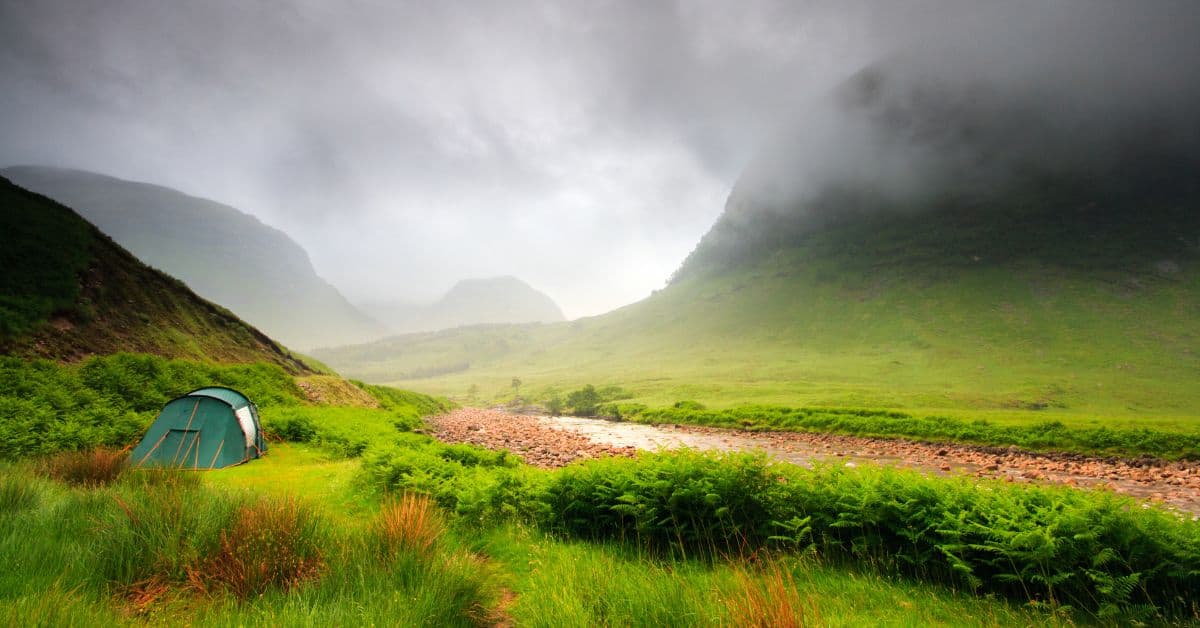I’ve set up camp under clear, sunny skies only to wake up to the unexpected sound of raindrops on my tent more times than I can count.
While it might not be everyone’s cup of tea, there’s something about the rain in the wilderness that feels raw and refreshing. Of course, it comes with its own set of challenges. Over my many nights of wild camping, I’ve picked up a tip or two about camping in the rain.
Whether it’s your first time braving the downpour or you’re just looking to up your rainy camping game, this guide’s for you.
Now let’s dive in and make the most of the wet weather!
Disclaimer: If you make a purchase via the links on our site, I may earn an affiliate commission at no additional cost to you. You can read my affiliate disclosure in the privacy policy. Thanks for your support!
Essential Tips for Mastering Camping in the Rain
Evaluating and Choosing Your Gear for a Rainy Camping Trip
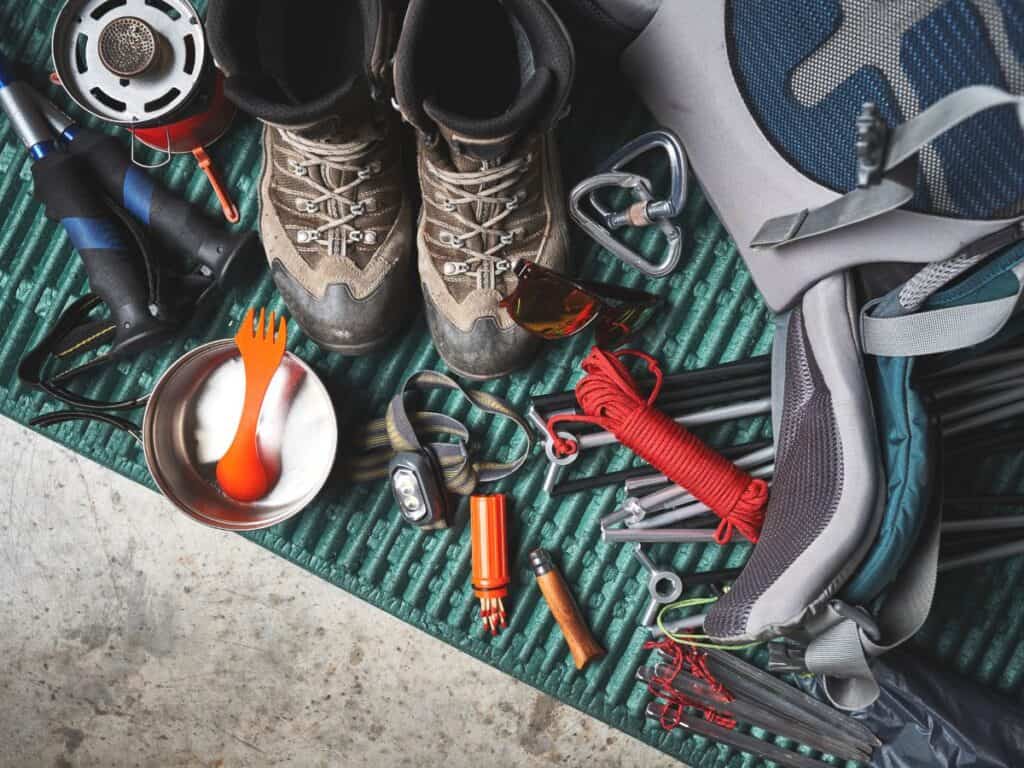
Understanding Tent Waterproof Ratings (Hydrostatic Head)
When you’re preparing for camping in the rain, the hydrostatic head rating of your tent becomes paramount. The higher the rating, the more rain your tent can withstand. Before your camping trip, ensure you’re familiar with this rating, especially if you’re expecting heavy rain.
Inspecting Tent for Potential Damages Before Your Camping Trip
It’s essential to inspect your tent for any damage before you set out for a spot of camping in the rain. Small tears or broken zippers can let in the rain, turning a cosy camp into a damp ordeal.
Selecting the Right Tent for Wet Weather and Cold Months
If your camping adventure is during the colder months, it’s essential to have a 4-season tent. These tents are not just about cold weather, they’re also designed to tackle wet weather, especially during heavy rain spells.
General Camping Gear Assessment for Wet Days
Besides your waterproof tent for wild camping, ensure your sleeping bags, camping gear, and other essentials are up to the task. There’s nothing worse than discovering your sleeping bag isn’t suitable for wet conditions or that your waterproof jacket isn’t as waterproof as you thought.
Reconfirming Tent’s Waterproof Integrity for Those Rainy Days
Although your tent may have a robust hydrostatic head rating, it’s still crucial to check its waterproofing state. Over time, exposure to the elements can degrade its resistance. If you’re questioning its ability to handle wet conditions, consider a re-waterproofing process.
Always Carry Spare Tent Pegs and Rope for Unexpected Windy Weather
Nature is unpredictable. Even if you’re prepared for the rain, strong winds can sometimes join the party. Having spare tent pegs and rope can be a lifesaver in such scenarios.
Packing Essentials
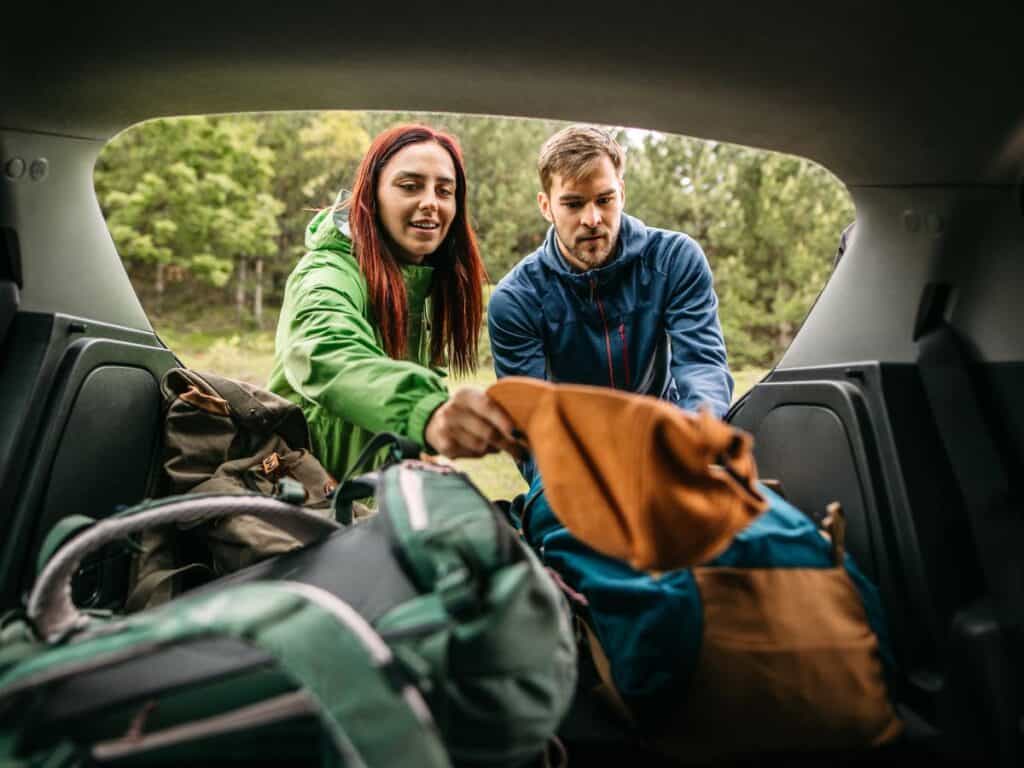
Jackets and Other Waterproof Clothing
Wet weather demands waterproof clothing and gear. A quality waterproof jacket can shield you from the rain, keeping your core dry and warm. Also, consider waterproof trousers to keep your lower half dry.
Waterproof Footwear
Wet feet can quickly lead to discomfort. Opt for waterproof boots or shoes to ensure your feet remain dry, no matter how soggy the ground gets.
Pack Lightweight Synthetic Layers
These can wick moisture away from your body, keeping you dry and comfortable even when you’re exerting yourself. Synthetic materials also dry faster than cotton, making them ideal for unpredictable wet conditions.
Use a Footprint or Groundsheet
Laying a groundsheet underneath your tent floor can act as an additional barrier against wet ground. This not only prevents water from seeping in but also protects your tent from sharp objects that might puncture it.
Use a Double-Layer Tent
A tent with a separate flysheet (outer layer) and inner tent can be more effective at keeping rain out. The double layers allow condensation to escape, reducing interior dampness.
Waterproof Bags and Dry Sacks
Essential for storing electronics, clothes, and other items that must remain dry. A dry sack can also compress items, making them easier to pack.
Waterproof Your Backpack
Even if your backpack claims to be water-resistant, a heavy downpour can still penetrate it. Consider using a rain cover or lining your pack with a heavy-duty bin bag for added protection.
Spare Clothing
No one likes being stuck in wet clothes. Packing a spare set of warm clothes allows you to change into dry clothes, ensuring you remain comfortable throughout your time camping in the rain.
Quick-Drying Towels
These are invaluable when you need to dry off quickly or wipe down wet gear. Opt for microfiber towels as they are lightweight, highly absorbent, and dry rapidly.
Waterproof Matches or Lighters
Wet matches are useless. Ensure you have waterproof alternatives so you can still light a campfire or stove during wet weather.
Elevate Your Sleeping Space
Use a camping cot or an inflated sleeping pad to lift you off the potentially wet floor. This not only offers added comfort but also provides an extra layer of insulation.
Entertainment for Rainy Days
Rain can force campers to stay inside their tents for a few hours. Board games, cards, or a good book can help pass the time and turn a rainy day into a cosy, fun experience.
Extra Blankets
Cold temperatures often accompany rain. Having extra blankets ensures you stay warm and cosy, even when the temperatures drop.
Each of these tips ensures that even when faced with rain, your camping trips remain enjoyable and comfortable. Incorporating them into your routine will make your rainy, outdoor adventures something to look forward to.
Setting Up Your Campsite
Weather and Campsite Planning

Check the Weather Forecast
Before embarking on any outdoor adventure, always check the weather forecast. While a little rain might not deter a seasoned camper like you, being prepared for what Mother Nature has in store will ensure a smoother camping trip.
Choose Where to Pitch Wisely
It’s essential to consider the ground and surroundings when setting up camp. Look for elevated areas to prevent rainwater from pooling around your tent. Avoid areas near trees with dead branches that could fall, especially during strong winds or heavy rain.
Avoid Camping Too Close to a Stream or River
While it might seem like a picturesque spot, setting up camp too close to a water source can be risky. Heavy rain can quickly cause these areas to flood, potentially washing away your gear and ruining your camping experience.
The Importance of Tent Orientation and Door Position
Think about where the rain and wind are coming from. Position your tent door away from prevailing winds to prevent rain from blowing into the tent’s interior surface when you zip and unzip.
Utilizing Natural Shelters for Advantage
Nature itself can provide some protection against rainy weather. Trees or larger rocks can act as windbreakers and offer some shelter against lighter rains. However, remember not to camp directly under a tree due to the risk of falling branches during strong winds or torrential rain.
Use a Tarp Shelter

Setting up a tarp over your tent, bivvy bag or camping area provides an additional layer of protection against rain. Not only can it keep your tent dry, but it can also create a communal space for activities when the rain is pouring. Plus, it’s a great spot to store gear temporarily.
Dry Firewood and Campfire Precautions
Keeping a supply of dry firewood ensures you’ll have a warm campfire, even after a downpour. If you’re expecting rain, store your firewood under a tarp or in a waterproof bag. When starting a fire in wet weather, use fire starters or dry kindling to get things going. Always make sure your campfire is in a designated and safe area, away from the tent and any other flammable items.
Cooking Precautions
Rain can make cooking a bit challenging. Consider using a portable camping stove with a windscreen or cooking under your tarp. Remember, safety first: never be tempted to cook inside your tent, as it poses both a fire and carbon monoxide risk.
Use a Hiking Pole for Tent Ventilation
Keeping your tent adequately ventilated helps reduce condensation inside. If your tent has a vent or a flap, propping it open with a hiking pole can improve airflow without letting rain in.
Prevent Tent Condensation
Moisture can accumulate inside your tent, especially during cold or rainy weather. Ensure you keep all air vents open, even during rain. The airflow helps reduce dampness, keeping the tent’s interior surface dry and preventing your sleeping bags and gear from getting damp.
By taking these measures when setting up camp in the rain, you’ll ensure a more comfortable, safe, and enjoyable camp, even when the weather isn’t on your side.
Managing Wet Conditions
Handling Wet Clothing and Gear
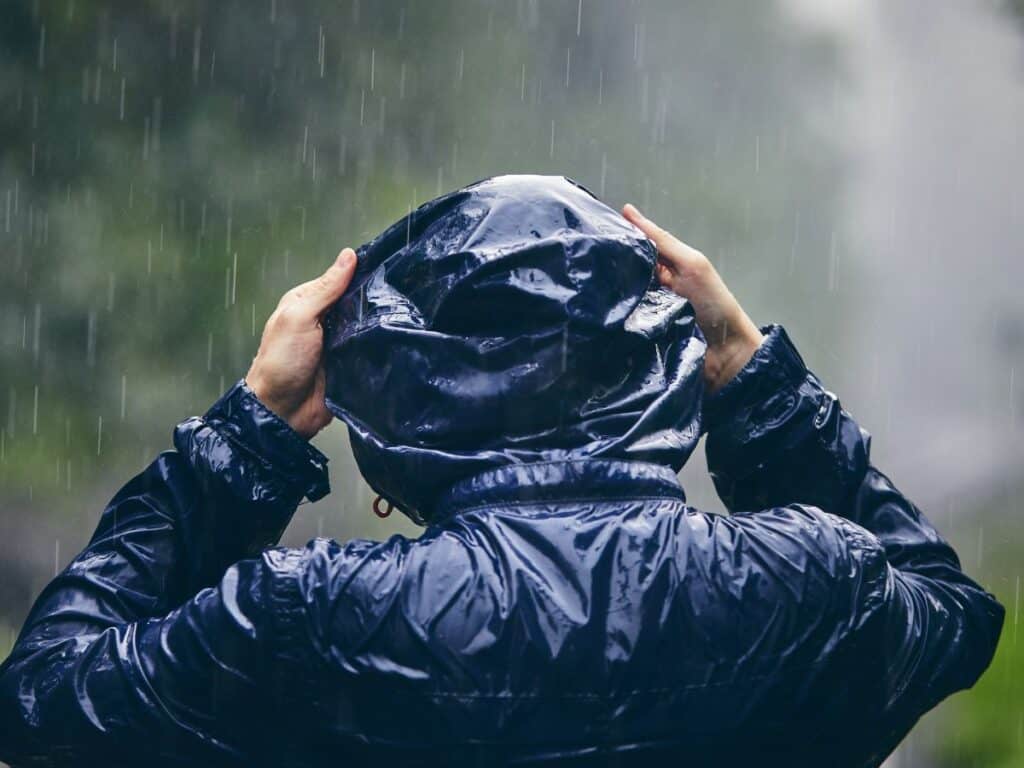
Leave Wet Items at the Door
After a day out in the rain, it’s essential to prevent the inside of your tent from getting damp. Always leave wet shoes, wet socks, jackets, and other gear outside or in a tent vestibule and hang wet clothes if possible. This helps maintain a dry and comfortable sleeping environment.
Gaiters for Wet Trails
If you’re trekking through muddy or wet trails, gaiters are a game-changer. They’re designed to cover the top of your shoes and lower legs, preventing water, mud, and debris from getting inside your footwear, and ensuring dry feet when camping in the rain.
Don’t Forget the Umbrella
While it may seem obvious, packing a sturdy umbrella can make those short trips outside the tent during downpours much more manageable. Whether you’re heading to another tent, collecting firewood, or simply enjoying the rain, an umbrella keeps you and your gear dry.
Health and Safety in Wet Weather

Antifungal Precautions
Wet conditions can be a breeding ground for fungal infections. Ensure your feet are dry before putting on socks and shoes. Consider using antifungal powders or sprays as a preventative measure, especially if you’re prone to conditions like athlete’s foot.
Wet Weather Survival Kit
When camping in the rain, ensure you pack a survival kit tailored to the conditions. This should include a waterproof lighter, emergency blanket, whistle, and a high-visibility waterproof jacket. Always be prepared for unexpected scenarios and bad weather.
Caring for Companions
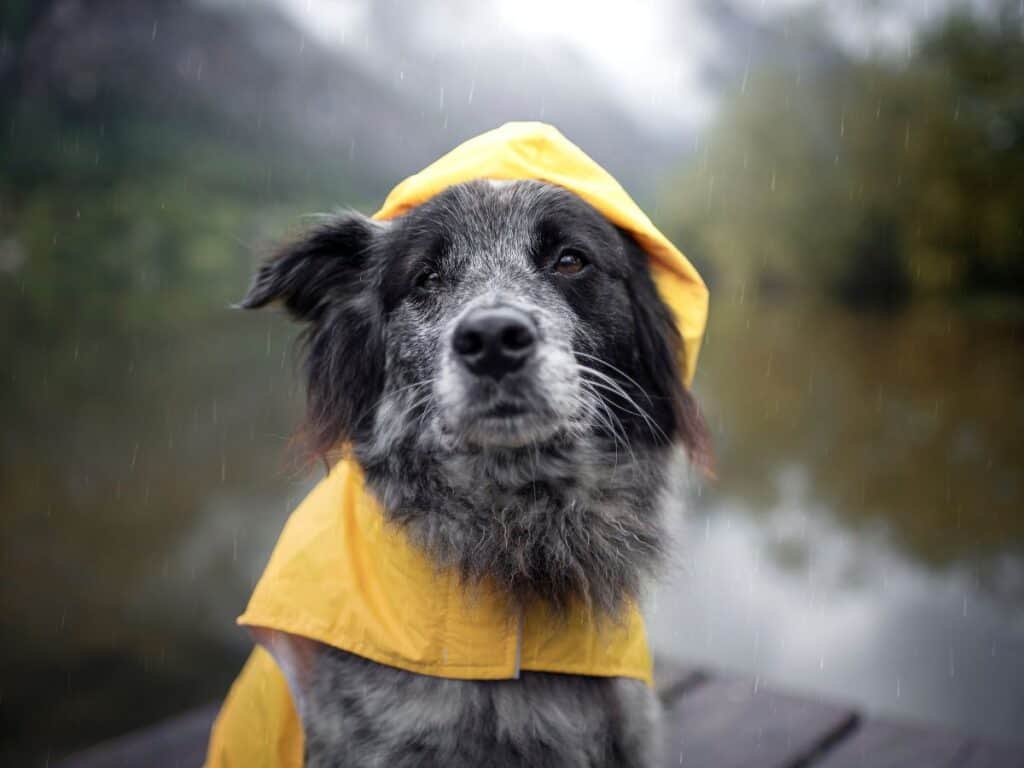
Pet Considerations
If you’re bringing your furry friend along, consider their needs too. Wet weather can be uncomfortable for them. Ensure they have a warm, dry shelter and check their paws for mud and debris after walks. It might be worth investing in a waterproof coat for them if they’re not fans of the rain.
Towels and Drying Solutions for Pets
After a day in the rain, your pet will likely be wet and muddy. Bring quick-drying microfiber towels specifically for them. These towels absorb moisture quickly, helping dry off your pet efficiently and keeping them warm. Plus, it helps prevent them from shaking off and soaking everything around them!
By managing wet conditions effectively, you and your companions can enjoy a comfortable and safe outdoor adventure, even when the skies are grey.
Post-Rain Camp Life
Packing Up and Post-Trip Care

Dry Equipment Properly
One of the critical mistakes campers make is packing away their gear whilst wet. This can lead to mould, mildew, and a deterioration of your equipment. Whenever possible, ensure all your items, especially tents and sleeping bags, are thoroughly dry before storing them. If the rain persists, try drying them out at home or in a well-ventilated area.
Pack Away Carefully
Care in packing up your wet gear can make your future camping trips far more enjoyable. Organise items, using plastic bags for damp pieces if needed, and ensure your gear is clean to avoid carrying dirt or mud the next time you use them.
Staying Positive in the Rain

Embrace the Experience!
Rain, though sometimes seen as a damper, can bring about a unique experience. The sound of raindrops on the tent, the fresh smell after a downpour, and the chance to see nature in a different light can be invigorating. So, rather than viewing it as a negative, embrace the rainy camping trip as an adventure all its own!
Final Thoughts
Rain doesn’t need to ruin your entire camping trip. With proper preparation and the right mindset, wet weather can be an opportunity to experience the outdoors differently. The next time clouds gather on your camping trip, remember these tips and embrace the adventure that rainy weather brings!
Camping in the Rain FAQ
Is it safe to camp in the rain?
Yes, as long as you’re prepared and have the right equipment. Be cautious of potential risks like flash floods and always choose your rainy campsite wisely.
How do I keep my sleeping bag dry?
Use waterproof bags, elevate your sleeping space, and always ensure your tent’s floor is free from water. Also, always leave wet clothes outside of your sleeping area.
Can you cook during rain?
Absolutely! Just ensure you have a sheltered area or use a pop-up canopy. Never be tempted to cook inside your tent due to carbon monoxide risks.
What do you do if it rains while you are camping?
If it starts raining during your camping trip, seek shelter in your tent or under a tarp, ensure your gear remains dry, and consider enjoying indoor activities or adapting to the wet weather with suitable outdoor adventures.
Is it safe to sleep in a damp tent?
Sleeping in a slightly damp tent can be safe but might be uncomfortable. However, in colder conditions, dampness can reduce the insulation properties of sleeping bags and potentially lead to hypothermia.
How much rain can a tent take?
The amount of rain a tent can handle is determined by its hydrostatic head rating. Higher ratings mean better water resistance but always refer to your tent’s specifications.
Can you touch a tent in the rain?
It’s best not to touch the inside of the tent when it’s raining. Doing so can create pressure points that allow water to seep through.
Should you set up a tent in the rain?
While it’s possible to set up a tent in the rain, it’s ideal to wait for a lull in the downpour or use a tarp to keep the interior dry during setup.
How long can a tent be wet?
You should aim to dry your tent within 24-48 hours. Extended wet storage can lead to mould, mildew, and potential fabric damage.
How do I keep the inside of my tent dry at night?
To keep your tent’s interior dry, ensure there’s proper ventilation, set up with a footprint beneath, and always keep wet clothing or gear outside or in vestibules.

About the Author
Steve Cleverdon is an adventure blogger dedicated to helping outdoor enthusiasts make the most of their outdoor experiences. With years of travel and many epic adventures including a 3000-kilometre solo hike across New Zealand, Steve has amassed practical knowledge on outdoor gear. You can learn more about his adventures here. Through expert reviews, recommendations, and guides, he equips his readers with the best gear for their next adventure. If you want to send Steve a quick message, visit his contact page here.

